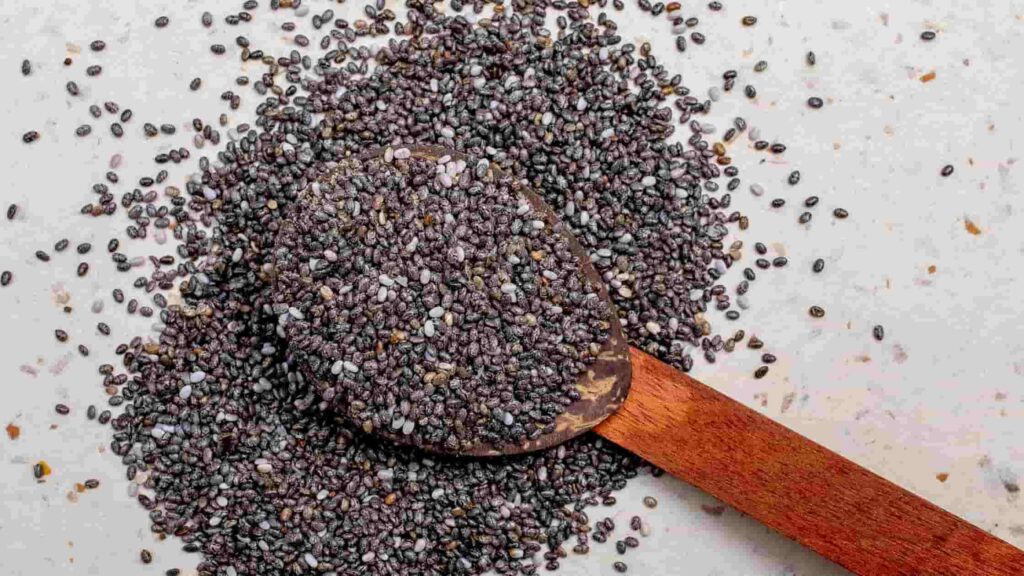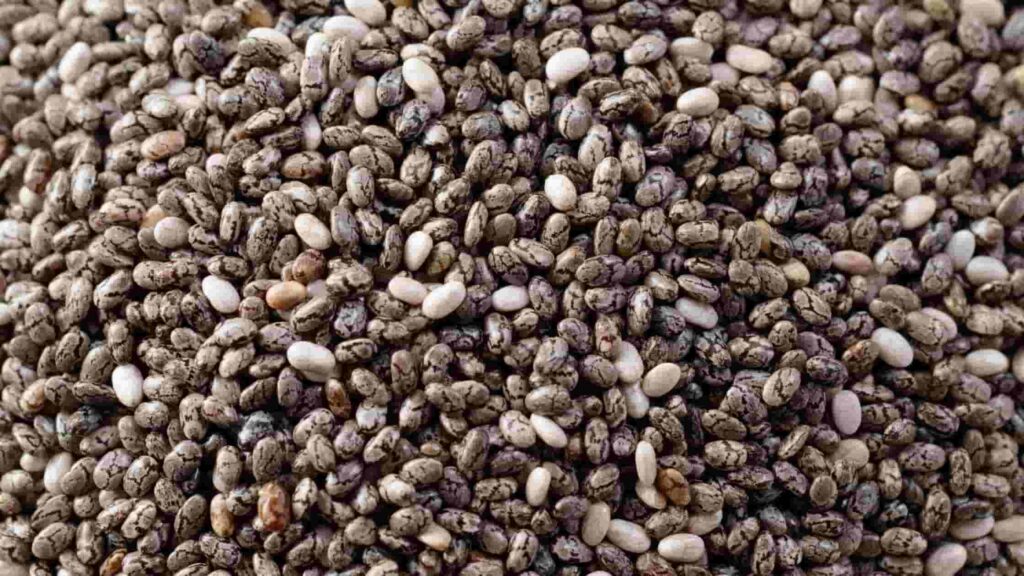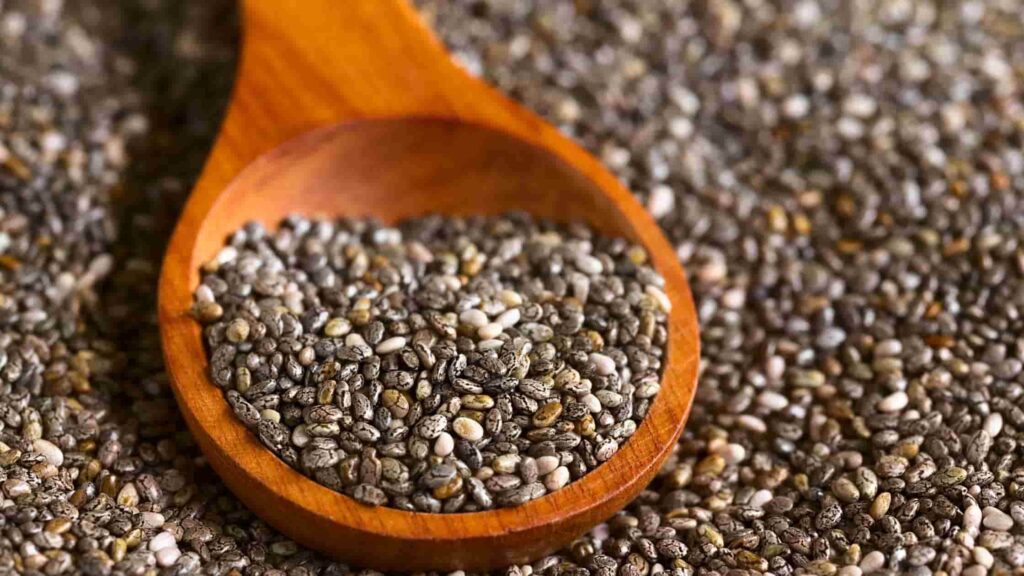When I first started adding chia seeds to my smoothies, I noticed I stayed full for hours without needing a snack. Over time, they also helped ease my digestion and boosted my energy in the mornings.
The Salvia hispanica plant produces chia seeds, which are small, nutrient-dense seeds that are high in fiber, protein, antioxidants, and omega-3 fatty acids. They are simple to incorporate into a variety of diets and promote weight loss, heart health, and digestion.
In this article we discuss about “Chia Seeds”
Table of Contents
What Are Chia Seeds?
Native to Central and South America, chia seeds (Salvia hispanica) are tiny, black and white seeds from a blooming plant in the mint family. The Aztec and Mayan civilizations employed these tiny seeds for generations because they were valued for their capacity to supply steady energy. In actuality, the Mayan term chia meant “strength.”

Once a staple crop in ancient Mesoamerican cultures, chia seeds are now cultivated in Mexico, Guatemala, Peru, Bolivia, Australia, and the U.S. Their remarkable nutrient density, versatility in recipes, and health benefits have earned them a place in the modern-day superfood spotlight.
Nutritional Profile of Chia Seeds:
1. Macronutrients and Calories:
An ounce of chia seeds, which is equivalent to two teaspoons or twenty-eight grams, offers:
- Calories: 138
- Protein: 4.7g
- Fat: 8.7g
- Carbohydrates: 12g
- Fiber: 9.8g
- Sugar: 0g
2. Vitamins and Minerals:
Chia seeds are abundant in vital elements, such as:
- Calcium: 14% DV
- Magnesium: 23% DV
- Iron: 12% DV
- Zinc: 12% DV
- Phosphorus: 20% DV
- Thiamin (Vitamin B1): 15% DV
- Niacin (Vitamin B3): 16% DV
- Manganese: 30%+ DV
- Selenium and Copper: Moderate amounts
3. Fatty Acid Profile:
Omega-3 fatty acids, notably alpha-linolenic acid (ALA), which promotes brain and cardiovascular health, are especially abundant in chia seeds. They include:
- Omega-3s (ALA): ~5g per ounce
- Omega-6s: ~1.5g per ounce
- Saturated fat: Very low
- Monounsaturated fat: Minimal
Top Health Benefits of Chia Seeds:
1. High in Antioxidants:
Quercetin, caffeic acid, kaempferol, and chlorogenic acid are just a few of the potent antioxidants found in chia seeds. These lessen inflammation, shield cells from oxidative damage, and may delay aging and minimize the risk of cancer.
Fun Fact: The antioxidants also protect the seeds themselves from going rancid despite their high oil content.
2. Heart Health and Cholesterol Regulation:
Chia seeds’ soluble fiber binds to LDL (bad) cholesterol in the digestive tract, reducing absorption. Their ALA content supports the maintenance of healthy blood vessels and may reduce blood pressure.
Human and animal studies show potential in lowering:
- Triglyceride levels
- Blood pressure
- LDL cholesterol
- Oxidative stress markers
3. Blood Sugar Regulation:
Thanks to nearly 10g of fiber per ounce, chia seeds slow glucose absorption, helping maintain stable blood sugar levels. Research has shown:
- Reduced post-meal blood sugar spikes
- Lower insulin resistance
- Improved glycemic management in individuals with type 2 diabetes
4. Weight Loss and Satiety:
The gel-like consistency that chia seeds develop when soaked can help you feel full longer. This slows down digestion and reduces cravings. Fiber and protein also contribute to appetite control.
- A 6-month study found greater weight loss in those consuming chia daily
- High fiber content improves gut health, promoting smoother digestion
5. Bone Health:
Chia seeds are an excellent plant-based source of calcium, making them a great option for vegans and lactose-intolerant individuals. Other bone-supporting nutrients include:
- Phosphorus
- Magnesium
- ALA (which supports bone mineral density)
Some animal studies also link chia intake with increased bone strength and density.
6. Supports Skin Health:
Emerging research shows that chia extract may protect skin from aging enzymes, improve hydration, and boost barrier function thanks to its fatty acids and vitamin F content.
7. Fights Inflammation:
Caffeic acid and omega-3s work together to combat systemic inflammation, a root cause of many chronic diseases such as arthritis, asthma, and heart disease.
How to Use Chia Seeds in Your Diet:
1. Soaking Chia Seeds:
Chia seeds’ hydrophilic qualities give them a gel-like consistency when soaked in liquid. They are therefore ideal for:
- Chia pudding
- Chia egg replacer for baking
- Thickening smoothies and soups
- Hydrating drinks (chia water)
Soak for at least 10–15 minutes for optimal texture and safety.
2. Eating Them Raw:
Raw chia seeds can be sprinkled on:
- Oatmeal
- Yogurt
- Salads
- Peanut butter toast
- Smoothie bowls
- Cereal or granola
Grinding the seeds helps your body absorb more nutrients, especially omega-3s.
3. Baking With Chia Seeds:
You can add chia seeds to:
- Muffins
- Breads
- Cookies
- Homemade energy bars
- Meat/fritter coatings (as a binding agent)
They’re flavor-neutral, so they blend well with both savory and sweet dishes.
How Much Chia Is Safe to Eat?
1. Can You Eat Chia Seeds Raw?
Yes, chia seeds can be eaten raw, and many people prefer consuming them this way for convenience. Raw chia seeds are tasteless and can easily be sprinkled over salads, yogurt, cereal, or blended into smoothies without altering the flavor.

However, since chia seeds absorb water and expand up to 12 times their weight, eating them dry without enough fluid may pose a choking risk or cause digestive discomfort. To safely eat raw chia seeds, it’s recommended to drink plenty of water alongside them or allow them to sit briefly in moist food like yogurt or oatmeal.
2. Chia Pudding, Smoothies, and Other Recipes:
Chia seeds, particularly when soaked, can be used in a wide variety of recipes. One of the most well-liked use is in chia pudding, which is created by mixing chia seeds with either dairy or plant-based milk and allowing them to sit for a few hours until they take on the consistency of gel. They also mix nicely with smoothies, giving them thickness and a protein, fiber, and omega-3 boost without changing the flavor.
Beyond that, chia seeds can be used in overnight oats, baked goods, homemade energy bars, salad dressings, or even as an egg substitute in vegan recipes. Their neutral flavor and hydrophilic nature make them ideal for both sweet and savory dishes.
3. Most experts recommend:
- 1–2 tablespoons (10–28g) per day
- Always drink water with them, especially if consuming dry seeds
Signs You’re Eating Too Much
- Bloating
- Gas
- Diarrhea or constipation
- Discomfort with high-fiber diet.
Risks and Precautions:
1. Common Digestive Issues from Overuse:
While chia seeds are a rich source of fiber, consuming them in large quantities—especially without enough water—can lead to digestive discomfort. Common issues include bloating, gas, constipation, and abdominal cramps, particularly for individuals not used to a high-fiber diet. The gel-like texture of soaked chia seeds can slow digestion, which helps with satiety but may also result in sluggish bowel movements if overconsumed.
On the other hand, dry chia seeds can expand in the stomach and potentially block the esophagus if not taken with sufficient fluids. To avoid these issues, it’s best to start with small amounts—around 1 tablespoon per day—and gradually increase your intake while ensuring you’re drinking plenty of water throughout the day.
2. Choking Hazard:
Dry chia seeds can swell rapidly when exposed to moisture. Never consume large amounts of dry chia without water.
3. Medication Interactions:
Because chia seeds naturally lower blood pressure and glucose, they can intensify the effects of:
- Diabetes medications
- Blood pressure medications
4. Allergic Reactions:
Though rare, some people experience allergies to chia. Symptoms include:
- Tongue or lip swelling
- Diarrhea or vomiting
- Skin rash or itching
In severe cases, anaphylaxis may occur.
Cultural and Historical Significance:
In the past, the Aztecs valued chia seeds more than gold. They served as:
- Tribute to emperors and priests
- A key military ration for energy
- Medicine and skin treatments

Colonial suppression of indigenous crops reduced chia’s popularity, but its resurgence in the 21st century has restored its rightful superfood status.
Frequently Asked Question:
1. What not to mix with chia seeds?
Avoid mixing chia seeds with dry foods or thick substances without adding liquid, as they can swell and cause a choking hazard. Also, avoid combining them with medications without medical advice, especially blood thinners.
2. What is the importance of chia seeds to a woman?
Chia seeds support hormone balance, bone health, and digestion due to their calcium, omega-3s, and fiber. They’re especially beneficial for women during menstruation, pregnancy, and menopause.
3. What happens to your body when you start eating chia seeds?
You may experience improved digestion, energy levels, and fullness. However, a sudden increase may cause bloating or gas if your body isn’t used to high fiber.
4. What happens if you eat chia seeds without soaking them?
Dry chia seeds can expand in the throat or stomach, posing a choking risk. They may also cause discomfort if not taken with enough fluid.
5. Are there any negative effects of chia seeds?
Yes, overconsumption can lead to bloating, gas, or constipation. Rarely, allergic reactions or medication interactions may occur.
6. Do chia seeds help in hair growth?
Omega-3 fatty acids, zinc, and protein found in chia seeds help promote healthy hair development. They support the health of the scalp and follicles but are not a panacea.
7. How do I use chia seeds for weight loss?
To increase fullness, soak chia seeds in water or incorporate them into meals and smoothies. Their fiber decreases nibbling and helps regulate appetite.
8. Which seed is best for weight loss?
Chia seeds, flaxseeds, and psyllium husk are all great, but chia seeds are favored for their fiber and omega-3 combo. They help curb hunger effectively.
9. What does Mayo Clinic say about chia seeds?
Chia seeds are a good source of fiber, antioxidants, and omega-3 fatty acids, according to the Mayo Clinic. For heart and digestive health, they advise including them in a well-balanced diet.
10. Who is not allowed to eat chia seeds?
People with swallowing difficulties, allergies, or those on blood thinners or diabetes medication should consult a doctor before eating chia seeds.
11. Can I soak chia seeds in yogurt?
Yes, chia seeds can be soaked in yogurt to make a creamy, nutrient-rich pudding. Let them sit for at least 15–30 minutes to absorb moisture.
Conclusion:
With a potent combination of fiber, protein, omega-3 fatty acids, and vital minerals, chia seeds are a nutritional powerhouse. They are an excellent complement to any diet because of their capacity to improve digestion, strengthen bones and skin, increase heart health, and encourage weight loss. Chia seeds are useful and adaptable whether consumed raw, soaking, or added to recipes like smoothies and puddings. But moderation is essential; you may safely get their full advantages by drinking them with adequate fluids and being aware of any medical issues or drugs.
